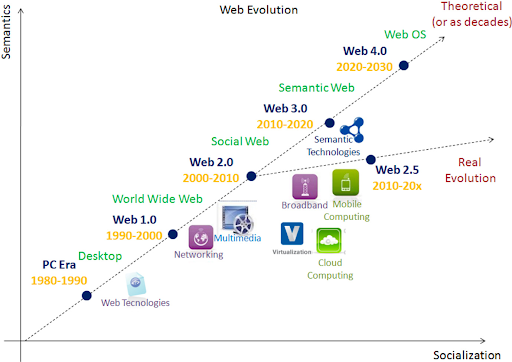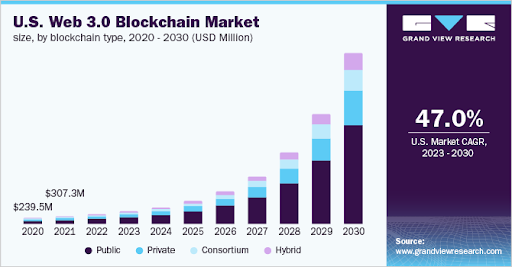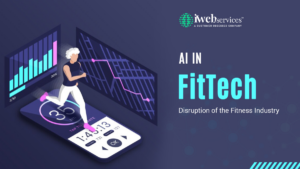Technology is continuously evolving, and so we see the Internet. We’ve gone through Web 1.0, Web 2.0, and now Web 3.0. But what’s the difference and which one is best for your business?
Well, with Web 1.0, businesses had access to an efficient way to spread their information. Web 2.0 offered users the ability to respond and interact with the content, leading to more engagement. Web 3.0 is marking the next milestone in the Internet revolution. It is promising to create a decentralized space with a more user-centric experience.
Sounds promising, right? But, do you really need to make the switch from Web 2.0 to Web 3.0? Or is it best to stick with Web 2.0?
Lots of confusion, right? Well, if you’ve been asking yourself this question, you’re not alone. Let’s take a look at the key differences between these two and which one may be better for your business. Web 3.0 vs. Web 2.0.
But before getting into that, let’s have a quick look at how things were before. With that, I mean the era of Web 1.0.
The Era of First Web Evolution (1990–2000): Web 1.0

Tim Berners-Lee introduced us to Web 1.0 in 1991 and it entered mainstream use in 1993. With the era of Web 1.0, the way people used the internet drastically changed and revolutionized our world as we know it.
It began with simple static HTML pages. The majority of the web’s content was created and edited by uniform professionals, which made it a commercialized, one-sided web. Have you ever stopped and wondered why this type of internet is so different from the web we are surfing today?
Basically, web 1.0 hit the brakes, limited user access, and stagnated technology advancements. It was a more refined and static kind of web, one that was mostly slow, and uniform and only a few had control over it. They were restricted features and users had less freedom to post content.
All in all, the main focus of Web 1.0 was to find and locate information, but the tricky part was that there wasn’t a lot of user-generated content. So while Web 1.0 had filled the need at the time, it wasn’t fulfilling and widely popular.
But it did lay the foundation for something that would change the internet and the way people used it forever. Can you guess what it was? Web 2.0 and its incredible capabilities, of course!
But does Web 2.0 triumph over Web 3.0 when it comes to businesses? Let’s explore.
Web 3.0 vs. Web 2.0- What’s The Difference?
”Every time there’s a new tool, whether it’s Internet or cell phones or anything else, all these things can be used for good or evil. Technology is neutral; it depends on how it’s used.” –Rick Smolan
Well-suited quote to describe the difference between Web 3.0 and Web 2.0. So what’s the difference? Are they really that different? Let’s understand in deep.
Understanding Web 2.0: What Is It?
Web 2.0 was this revolutionary upgrade when it was released in 2004 and it has transcended a conventional web into something much better. This development has pushed businesses to embrace a more interactive medium with their customers while at the same time leveraging technology to provide better user experiences.
HTML, CSS, JavaScript, AJAX, and JSON are some of the tools used by web development companies and web app developers to give websites the kind of interactivity users crave. Web 2.0 is undoubtedly the yeast that has molded the world wide web into the giant it is today.
Characteristics of Web 2.0
Web 2.0 is characterized by several features that distinguish it from the previous generation of the web:
- Collaboration: The web pages are designed to be highly interactive and engaging, where the user is no longer just a spectator but also an active participant. Instead of merely browsing through a Web 2.0 page, users are allowed to join the discussion by leaving comments, creating accounts or profiles and, ultimately, contributing to the website’s content and functionality.
- Interactivity: Not only for entertainment purposes but corporations have also capitalized on the advantages of Web 2.0 such as social networks, content management systems, etc._ to gain valuable insights from customers and at the same time shape user experiences.
- Folksonomy: Introduces a free classification of information to make the searching experience easier for users by allowing them to collectively classify and find information by the way of “tagging” websites, images, videos, or links. It is an amazing tool that has made researching and exploring a breeze.
- Rich user experience: As the name itself implies, provides an interactive encounter for the user by embracing their inputs. This includes the user enlarging an image after a “click” or obtaining more information about the same.
- Software as a Service: SaaS has opened new doors in terms of web development and utilization. Instead of having software installed on individual computers, APIs have been developed to allow an automated approach to software services, such as a Web “App” or a mashup.
Examples of Web 2.0
Web 2.0 encompasses a wide range of sites and applications, including
| Category | Examples |
| Social networking | Facebook, Twitter, Instagram, |
| Collaborative projects | Wikipedia, GitHub, Google Docs |
| Content sharing | YouTube, Flickr, SoundCloud |
| Communication | Skype, WhatsApp, Slack |
| Productivity tools | Trello, Asana, Evernote |
Understanding Web 3.0: What Is It?
As we arrived in 2010 and beyond, we witnessed the dawn of a new stage for the Web: Web 3.0. It is marked by the Semantic Web featuring more personalized services driven by AI that offer a whole new level of user experience.
Web 3.0, also known as the Semantic Web, is the next generation of the Internet. It is an evolution of Web 2.0 that aims to create a more intelligent and connected web. While Web 2.0 was focused on user-generated content and social networking, Web 3.0 is focused on data integration, artificial intelligence, and machine learning.
It is often described as the “intelligent web” because it uses advanced technologies to understand and interpret data. It is a web of linked data that can be easily accessed and analyzed by machines. This allows for more accurate and relevant search results, as well as more personalized and efficient user experiences.
Characteristics of Web 3.0
Web 3.0 is characterized by several key features:
- Decentralization: By relying on technology such as blockchain and peer-to-peer networks, Web 3.0 enables a decentralized network architecture that makes it more efficient and secure compared to previous versions of the web.
- Semantic Web: Besides being an information network, web 3.0 will also be an intelligent platform with the potential to tap into the hidden potentials in the data. Natural Language processing, machine learning, and artificial intelligence are some of the technologies that will power this intelligent layer of the web.
- Interoperability: Web 3.0 technologies promote the sharing of information between users and websites, creating an interconnected ‘mesh’ environment in which data can be seamlessly shared across the entire web.
- Intelligence: The combination of semantic web technologies, data mining, and artificial intelligence allows websites to recognize user behavior and thus generate content according to what the user is likely interested in.
Examples of Web 3.0
Some examples of Web 3.0 technologies and applications include
| Category | Examples |
| Social Networks | Sapien, Steemit, Sola |
| Exchange Services | IDEX, EOSFinex |
| Messaging | e-Chat, Obsidian, ySign |
| Storage | Storj, Sia, Filecoin |
| Insurance and Banking | AiGang, Everledger, Cashaa |
| Streaming (Video and Music) | LBRY, LivePeer, UjoMusic |
So what do you think? Web 3.0 or Web 2.0? Which one is better for our business?
Comparison Between Web 2.0 and Web 3.0
Choosing between Web 2.0 and Web 3.0, it’s an apples-to-oranges comparison – what’s right for one business may not be right for another. The decision of which version to go with will all depend on your needs. Web 2.0 is great because it’s user-friendly and relatively easy to use, while Web 3.0 offers a range of advanced features you ought to consider.
But the ultimate decision lies with the type of business you own. If you’re still on the fence about which web version to use for your business, consider consulting with a web development company that can guide you through the best solution for your individual needs.
- User Interface
Maybe it’s not as tech-savvy as its predecessor, Web 2.0, but Web 3.0 has its own benefits – one of them being data control for the user, thus making it much more secure than ever before. Web 2.0 offers the advantage of real-time updating of information with a dynamic user interface, which makes it easier to use and understand, yet it is controlled by tech giants.
So, it all boils down to the needs and specifications of your business. Nevertheless, both technologies have their own share of proficiencies and have the potential to drive businesses to higher levels of success.
- Ownership
Web 3.0 has brought in the most significant revolution ever seen. Unlike in Web 2.0, where the data is controlled by a centralized authority providing a personalized user experience, Web 3.0 works on a decentralized principle wherein the user has complete control over their data. On the plus side, it gives users more control over who has access to their data, ensuring greater privacy and security.
- Security & Privacy
Web 2.0 applications are clearly governed by centralized authorities and the owner decides the security protocols of the data. No wonder it could be a cause of concern when your valuable information is at stake.
With Web 3.0 applications, things get somewhat spine-tinglingly exciting. No requirement for personal information is enough to make us jump with joy. Not only that, the availability of tokens just adds to the fun. But hold your horses, because it does sadly mean that scaling up will be as hard as cracking a vault! That’s a lot of maneuvering one has to execute if wishing to expand the business.
- Technologies
Web 2.0 application development involves utilizing a tech stack comprising multiple databases and languages including JavaScript, AJAX, and more. Alternatively, Web 3.0 application development is significantly structured around the amalgamation of technologies such as AI, ML, Blockchain, and other advanced solutions. It further becomes unparalleled in terms of its complexity and computing power.
- Transparency
A cornerstone of Web3 is transparency. It entails a degree of visibility into the information that transcends the participants in a transaction. For example, money passing hands between two parties can be viewed by each entity on the network, eliminating any chance of foul play. This open-source access to information implies that the need for building trust between parties is greatly reduced, shortening the processing time for transactions significantly.
- Operations
The endeavor of Web 2.0 versions necessitates hours of hard work and cohesion to smoothen the business processes. To revolutionize the process, Web 3.0 offers the ingenious approach of Smart Contracts for sharing the trade logs amongst the stakeholders and allowing them to have vital-time insight and access. All these elevate the prospects of transactions.
Let’s now make a comparison and understand how Web 2.0 and Web 3.0 differentiate in terms of distinct features and user experiences.
Web 3.0 vs. Web 2.0: Table Comparing Web 2.0 and Web 3.0
| Criteria | Web 2.0 | Web 3.0 |
| Definition | Read-and-write phase | Read-write-execute phase, emphasizing Semantic web |
| Focus | Connect people | Connect knowledge |
| Target Area | Community building | Empowerment of users |
| Technologies | AJAX, JavaScript, CSS3, HTML5 | Decentralized protocols, semantic web, AI |
| Types of Applications | Web apps, two-way websites, video websites, podcasts, individual blogs | Smart applications, integrated gaming, 3D portals, multi-user virtual environments |
| State of Data | Network owns data | Data owned by an entity and shared freely throughout the network |
| Features | Wide variety of web apps and social media apps, interactive advertising | Intelligent web-based functionalities and applications, behavioral marketing |
Web 2.0 and Web 3.0 are different generations of the internet with distinct characteristics, technologies, and features. The comparison table above highlights the main differences between the two, including their definition, focus, target area, technologies, types of applications, state of data, and features.
No doubt, Web 3.0 brings a whole lot of exciting new prospects, and you might be itching to take the plunge and switch from Web 2. But first, here are a few things you should know. Make sure you are adequately prepped and ready for the change!
Web 3.0 vs. Web 2.0: What Makes Web 3.0 Better Than Web 2.0 for Businesses?
Web 3.0 offers a myriad of advantages for businesses when compared to Web 2.0, all of which are grounded on the following points:
Lack of Third-Party Intermediaries
- Decentralized blockchain technology enables information to be processed on multiple devices, rather than a central server.
- Companies will be able to process data more efficiently across multiple devices.
Customer Relationship Management
- Traditional CRM techniques are often limited due to data restrictions. But, Web 3.0 technology can leverage sources such as social media and surfing history to gain a better understanding of customer preferences.
- This will result in customized services and a better chance of connecting with customers, leading to increased sales and customer loyalty.
New Marketing Outlook
- Web 3.0 opens up opportunities for sophisticated segmentation and marketing research. Businesses may target customers more successfully with access to sophisticated data
- Real-time data is tracked by apps to target customers better.
How iWebServices Can Help You With Your Web 2.0 and Web 3.0?
The global Web 3.0 blockchain market has evolved over the years, registering a whopping CAGR of 47.1%. By 2030, it is expected to reach USD 1.73 billion.

In case you are confused between Web 3.0 and Web 2.0, don’t fret! iWebServices is here to rescue you with the right advice and implement the right solutions.
Our esteemed panel of tech-savvy professionals has unparalleled expertise in blockchain, App development, Metaverse-based solutions, mobile app development, and Web 2.0 solutions.
With us by your side, get ready to take full advantage of the latest technology advancements like Web 3.0. So go ahead, blockchain developer from us, and reap the benefits. Not just that, even if you are looking to develop dApp or any other mobile application, hire mobile app developers without any second thought.
Web 3.0 vs. Web 2.0: Final Say!
It’s a tough call between Web 3.0 and Web 2.0 – which one do you choose? Web 2.0 has a proven history of success, but Web 3.0 offers exciting innovative options that are hard to ignore.
From customer protection and scale to creating immersive experiences for users Web 3.0 can provide, the journey towards success might be through one or the other. However, the ultimate decision lies in the hands of the individual business – so take an account of your own needs and goals to pick the suitable platform. Besides, with the new generation of web technologies, you can deliver your content in a more interactive and engaging way. Moreover, if you are thinking of developing an Andriod app or iOS app with the integration of the latest tech like blockchain, AI, etc. hire an Android app developer or iOS app developer for your business.
 April 6, 2023
April 6, 2023







